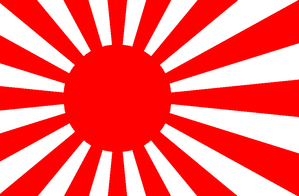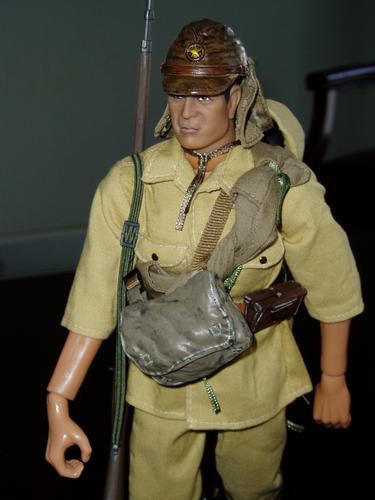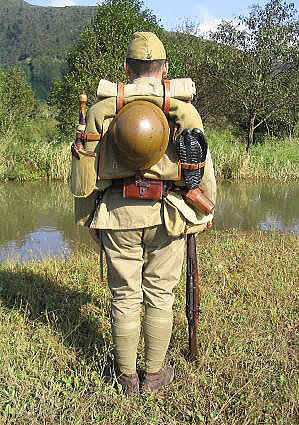


IJA Organization
The Imperial Japanese Army was primarily an infantry oriented army with the main focus being on keeping as high as possible the number of infantry divisions, though the infantry battalion was considered the smallest tactical unit capable of independent combat operations.
Divisions built around Brigades:
Between 1905 and 1936 the standard Japanese infantry division was organized around two infantry brigades which were most often deployed into two equal combat teams. In the pre-war era each Brigade would have two infantry regiments. These were normally known as “square divisions”. Many of these, about 75% were converted over to three regiment “triangular divisions”. There were several different types of brigaded divisions with over all troop strengths varying by type from 20,000 men down to 12,000 men.
In China the IJA activated about four smaller brigaded divisions for use in the counter insurgency fight. They each had the normal two brigade structure but each brigade instead of regiments had four independent infantry battalions. There were light artillery in the subunits but no separate artillery unit as was normal in brigade and divisional structures elsewhere. Given that the purpose of these units was counter-insurgency they tended to lack what is deemed adequate levels of signal, anti-tank, anti-aircraft, tanks, and transportation assets for fighting a normal conventional military foe.


A similar organizational structure was also used in the Philippines though these four divisions typically had only 10,000 soldiers assigned to them. Two other square divisions stand out for their heaviness. The first was the 91st Infantry Division and the second was the 109th Infantry Division. The 91st had six infantry battalions in each of its two brigades and had extra quantities of artillery, anti-tank weapons, anti-aircraft weapons and engineers. The 109th Division was stationed in the Volcano Islands, which included Iwo Jima. This division had the normal two infantry brigades but it also had an independent mixed infantry regiment, a divisional support regiment, tanks, and heavy artillery.
Triangular Divisions:
After 1936 the Japanese adopted a triangular organization with three infantry regiments to a division. Though this was the desired make-up of an infantry division it was by no means universal and some square divisions were left intact. The Japanese recognized four types of triangular infantry divisions. These were identified by the composition of the divisions organic units. These organic units were classified as one of three types; A, B, and C. A type A designation was a strengthened version of the standard type B organization. If a unit was type C this indicated that it was a specialized formation not necessarily following or deriving from the standard organizational tables.
So now that we have identified the classification of division’s organic components we can identify the four types of infantry divisions. The standard infantry division was completely organized around type B sub-units and was authorized a troop strength of 20,000. It was made up of; a division headquarters (HQ), signal unit, infantry group of three infantry regiments, artillery regiment, cavalry or recce regiment, engineer regiment, medical unit, two field hospitals, water purification unit, transport regiment (If the Division was stationed in China it typically had 32 assigned transport trucks and 2,400 pack animals. Those Divisions outside of China had 100-150 transport vehicles and 2,400 pack animals. The pack animals were organized into eight pack transport companies in a single battalion.), ordnance unit, and a veterinary unit.
The strengthened infantry division followed the same template except that its components were type A and that it had the following additional units assigned to it; an additional artillery regiment, a tank unit, and a chemical warfare unit.
There was also the strengthened modified infantry division. This followed the same template as the strengthened division except that it had no tank unit and no chemical warfare unit. In addition to this the infantry companies did not have a heavy weapons platoon. These strengthened divisions had authorized troop strengths which varied between 24,600 men up to 29,600 men.
The final type of Japanese infantry division was the special division. This division was notably lighter in its make-up revolving around two regiments with two independent rifle battalions each. Each regiment and battalion was supported by type C auxiliary support units. These units were mostly used in counter insurgency operations in China and appear to be a modified form of the older square division.
A final type of infantry division used (five were known to have been organized) was the Regimental combat team division. These had the standard three infantry regiments. How ever there was no field artillery at the divisional level. Each regiment instead was granted an artillery battalion. The division was also assigned a tank battalion and usually compensated by eliminating its engineer unit.
If a Japanese Infantry Division was noted as motorized then it typically followed a type B format but that it had additional motorized transport in the divisional transport units.
Each division recruited its troops from an assigned recruitment area with the regiments assigned districts with in the divisional area.
Divisional Components:
The basic component of all these types of infantry divisions was the infantry group, which was typically a grouping of three infantry regiments. The standard infantry regiment consisted of a; HQ, three rifle battalions, a signal company, a regimental gun company, and an anti-tank company. With in this regiment there were 2128 rifles, 114 light machine guns (LMG)[6.5mm], 108 50mm mortars (LMRT) (also known as grenade dischargers. Allied experience indicated that the Japanese were very adept and keen on this weapon), 24 heavy machine gun (HMG)[7.7mm], 6 37mm or 47mm anti-tank guns (ATG), 6 70mm battalion guns, 4 75mm regimental guns, 673 horses, and 3845 men.
The core of an infantry regiment was its infantry battalions. The standard infantry battalion (type B) was made up of; HQ, 4 rifle companies, HMG Company, and a battalion gun platoon. It had 1100 men, 677 rifles, 37 LMG, 36 LMRT, 12 or 8 HMG, and 2 70 mm battalion guns.
A strengthened infantry battalion had the same basic configuration with the addition of an anti-tank company. It had; 1626 men, 730 rifles, 37 LMG, 49 LMRT, 4 HMG, 8 20mm anti-tank rifles (ATR), 4 37mmATG, and 4 70mm battalion guns.
A strengthened modified infantry battalion had a; HQ, 4 rifle companies, a HMG company, and a battalion gun company. It listed out at 1401 men, 750 rifles, 37LMG, 49 LMRT, 12 HMG, 8 20mmATR, and 4 70mm battalion guns.

A Major with a total strength of 147 men commanded the normative battalion headquarters. It was sub-organized into; an administrative section, ordnance and intendance section, liaison, code and intelligence section, and a HQ guard or antiaircraft section. The bulk of personal, 110 men, soldiered in the battalion trains though this number would be reduced if motor transport were used.
The primary building block of an infantry battalion was the rifle company. The standard, type B, rifle company was commanded by a Captain and was further divided into; HQ, and three rifle platoon. The total strength of the company was 181 men, 139 rifles, 9 LMG, and 9 LMRT.
The rifle company Type A with out a heavy weapons platoon had a; HQ, and three rifle platoons. 205 men, 105 rifles, 9 LMG, and 12 LMTR manned it.
The rifle company type A with a heavy weapons platoon had 262 men organized into a; HQ, three rifle platoons, heavy weapons platoon, and an ammunition platoon. It equipment consisted of 150 rifles, 9 LMG, 12 LMTR, 2 HMG, and 2 20mmATR.
Besides the rifle companies the other battalion sub-units were machine gun and battalion gun units.
There were two types of machine gun companies in an infantry battalion. The first type was the 8-gun company with; HQ, 4 machine gun platoons and an ammunition platoon. It had 144 men, 8HMG with two in each machine gun platoon, with each machine gun platoon having two sections of 11men and one HMG each. This was the most common type of machine gun Company assigned to an infantry battalion.
The other type of Battalion machine gun company had 73 men and 4 HMG organized into a; HQ, 2 HMG platoons, and an ammunition platoon. The HMG platoon was organized the same as the platoon in the other machine gun company. The difference in the number of machine guns between the two types of companies is because in version number two the additional HMG have been directly assigned to the rifle companies.
Infantry battalions could have either gun companies or gun platoons. In the gun platoon were a HQ, two gun sections and an ammunition section. The guns were 2 70mm battalion guns with a complement of 55 men.
Gun companies were of two types, those with and those with out ATRs. The gun company with out ATRs had a HQ, 2 firing platoons and an ammunition platoon. 122 men and 4 70mm battalion guns
In the version with ATRs you would have seen a HQ, 2 firing platoons, an ammunition platoon, and 4 anti-tank platoons, with two ATR squads each. The total strength was 4 70mm battalion guns and 8 20mmATR.
Moving down the organizational chart from the company to the platoon and squad level we will find a variety of organizations but it is important to remember that a squad was view as a whole with out sub-units.
The type B rifle platoon had 54 men organized into three LMG squads and 1 LMRT squad. Each squad had 13 men and the LMG squads had one LMG each with the LMTR squad having 3 LMTRs.
The type A rifle company with out a heavy weapons platoon organized its rifle platoons as follows; 3 LMG squads and 1 LMTR squad. The platoon had 62 men with 15 in each squad.
The type A rifle company with heavy weapons were organized like the other type A units but it had in addition to the regular platoons a heavy weapons platoon which was configured into 2 HMG sections and 2 ATR sections each with 11 men and one of either type of weapon.
Specialized Divisions and Forces:
The other types of Japanese infantry units were the independent regiments and battalions, airborne, fortresses and though they were wholly under the navy we will briefly talk about the special naval landing forces (SNLF).
Independent Formations:
The independent units were mostly organized along standard lines with additional parts added on or subtracted based on the needs of the mission. The Japanese never hesitated to create a special task force type unit. During the last two years of the war there was an increase in the number of new independent units as this was a way to still activate new troop formations even though the Japanese lacked the needed support weaponry and equipment to raise it to a division level. There was also a marked tendency to cobble together existing independent units which had support material into divisions. There was also a tendency to for independents into sub divisional components for attaching and task organizing. For instance there were several independent infantry groups formed which were basically the infantry component of a standard division (three regiments) with no supporting arms. These could be used independently, attached to an existing unit, or used as the nucleolus for a whole new division.
In addition to the independent infantry group there were also independent mixed brigades which consisted of five infantry battalions, artillery battalion, engineer company, and a signal company. These were used mostly in China and had a troop strength of some 6,000-10,000 men. There were also independent brigades with no supporting arms but still having five battalions of infantry. They same general rule applied to independent infantry regiments, standard organization minus the supporting units. Though an independent mixed regiment would have artillery, signals, and engineers much like an independent mixed brigade.
Fortress,Depots,Airborne,and Replacements:
The fortress troops were of standard composition with added units of engineers, artillery, signal, and anti-aircraft artillery.
The Depot divisions were the training and equipping units for mobilized soldiers. They were not expected to perform actual combat actions. They also provided refresher training for reservists and later in the war, notably in 1943, several were disbanded and the cadre used to form new combat units. The Replacement units were more often of regimental size and served as the builders of new units by amalgamating returning wounded into coherent units and providing garrison troops.
In Manchuria/Manchuko there was also deployed several Independent Garrison Units. These had from four to six infantry battalions and were tasked with rail line security.
Japanese airborne units followed standard organizational templates though were mission configured..
The SNLF:
The SNLF were organized in four bases in the late 1920’s and were wholly composed of naval personal. They began to see operational use in 1932. These early units were battalions of about 2000 men each. The battalions had 4 companies. Three of the companies had 6 rifle platoons and a HMG platoon, the # 4 company had three rifle platoons and a heavy weapons platoon which had either 4 3inch naval guns or 2 70mm battalion guns and 2 75mm regimental guns. They would also have tanks and armored cars attached depending on mission and terrain. These units though excellent at landing operations showed a lack of good infantry skills and abilities and when they came up against solid opposition tended to fair poorly.
The early part of WWII saw the SNLF being used as a heavily armed mobile strike force. Typically it was configured as a group with 2 rifle companies, each with a HMG platoon, 1-2 heavy weapons companies which had HMG and ATG and some times anti-aircraft artillery and tanks. The force usually had additional signal, engineering, transport and medical troops with a force package in the range of 1200-1500 men being the norm.
Later in the war as Japan was forced to defend the composition of the SNLF evolved again this time even heavier. There was an increase in heavy guns with companies being made up of 3 rifle platoons and an 8 gun HMG platoon.
The last type of organization noted in the records was of infantry platoons in China having 6 squads of 8 men, three of the squads with LMG the rest pure rifle.
Now that we have detailed the basic infantry organization let us briefly look at the higher echelons of the Imperial Japanese Army.
Above the division was the Army. There was no set pattern for how many divisions plus support troops made up an Army but the mission tended to dictate. A guideline is between 50000 and 150000 men.
A grouping of armies in a theater was known as a Group of Armies. The supreme commander of all Japanese forces was the Emperor followed by the Imperial HQ and then the Army Heads.
In 1941 Japan had 2,250,000 men under arms with 1,250,000 in Manchuria and Northern China the rest being divided between Korea, Japan, and Formosa. Japan also had 4,500,000 trained reserves.
At the end of the war the Japanese had lost close to 1.5 million troops and the remaining forces were stationed as follows: Japan – 2,115,000, N. China/Korea/Manchuria – 1,310,000, SE China/Malay/Burma/Indochina – 953,000, Formosa/Philippines/Indonesia- 772,000.
 General (Taisho) |  Lieutenant-General (Chujo) |  Major-General (Shosho) | |
 Colonel (Taisa) |  Lieutenant-Colonel (Chusa) |  Major (Shosa) | |
 Captain (Tai-i) |  1st Lieutenant (Chu-i) |  2nd Lieutenant (Sho-i) |  Warrant Officer (Jun-i) |
 Sergeant-Major (Socho) |  Sergeant (Gunsho) |  Corporal (Gocho) |  Lance Corporal/ Leading Private (Heicho) |
 Superior Private (Jotohei) |  Private 1st Class (Ittohei) |  Private 2nd Class (Nitohei) |  Recruit |
 Officers' Cap Badge |  Enlisted & NCO Cap Badge |
 Acting NCO Shoulder Chevron |  Acting Superior Private Shoulder Chevron |






















/idata%2F0396584%2FKOREA%2F71910_korea_MIA1_800.JPG)
/idata%2F0396584%2FU.S.ARMY-POST-WW2%2Fphot4901a.jpg)
/idata%2F0396584%2FDRAWINGS-UNIFORMS-WW2%2F30-451-09b-2.jpg)
/idata%2F0396584%2FP-40%2F44FS000.jpg)
/idata%2F0396584%2FGERMAN-U-BOAT%2FBundesarchiv_Bild_101II-MW-1031-28-_Lorient-_U-31.jpg)
/idata%2F0396584%2FSOVIET-ARMY-WW2%2F1.jpg)




